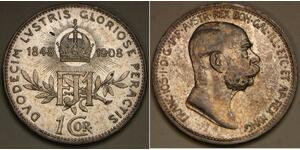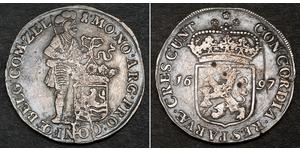(sold for $23.0)
1819, Great Britain. Gilt Bronze "MP Election of Sir Charles Cockerell" Medal.
Mint Year: 1819 Region: Warwickshire Medallist: J. P. Suffield Reference: D 75, Withers 365. Condition: Damaged (pierced and plugged, edge hits, etc.), gold plated (gilt), otherwise VF-XF/VG-G! Denomination: Medal - Sir Charles Cockerell (1755-1837), Election as MP for Evesham Validated in 1819. Material: Bronze (gold-plated) Weight: 65.95gm Diameter: 53mm
Obverse: The Bell Tower, Evesham, seen through the Cloister Arch Legend. UNION COPPER COMPANY . BIRMINGHAM .
Reverse: Large vlaue in words ("ONE PENNY TOKEN"). Legend: FOR PUBLIC ACCOMODATION . . * . .
The free standing bell tower is the only surviving part of Evesham Abbey, which was founded by Saint Egwin between 700 and 710 AD. The tower was built by Abbot Lichfield in the early part of the 16th century.
In 1513, Clement Lichfield built the St Clement chantry of in All Saints Church, Evesham and in 1514, he became Abbott of Evesham Abbey. In 1524, John Molder bequeathed 40 shillings to a "new Towre for their bells". Records show in 1204, the Abbey's central tower collapsed and again in 1264, so this may have been part of the decision to build a free standing bell tower instead, as at Chichester Cathedral.
Construction commenced in 1531 under the supervision of Abbott Lichfield. It is unknown when the tower was completed, but it was certainly finished by 1539 when Evesham Abbey was surrendered as part of the Dissolution of the Monasteries. Over the next few years, the Abbey, which was known to be one of the richest monasteries in England, was dismantled completely, apart from, curiously, the then new bell tower. The tower is 110 feet high.
In 1664, the four bells from the neighbouring churches of All Saints and St Lawrence were recast and added to the two bells already in the Bell Tower, giving a peal of six bells. In 1741, Abel Rudhall recast five of the six bells, keeping the largest bell from 1631, and casting two new bells to augment them to eight bells. The tenor bell was said at that time to weigh 29 long hundredweight. The tenor bell was recast in 1821 by Thomas Mears and increased in weight to 31 long hundredweight. By 1910, they were very hard to ring, were rehung and augmented from eight bells to ten.
The resulting ring was still considered to be poor compared to many rings being turned out by John Taylor & Co of Loughborough during the time, so in 1951, the present ring of bells was created by recasting all ten bells at Taylor's foundry in Loughborough and augmenting them to twelve. Two semitone bells were cast later by Taylor's, one in 1976 and one in 1992, which enables a light ring of ten bells to be rung without using the three heaviest bells. The bells are considered to be one of the finest sets of change ringing bells anywhere in the country.
Sir Charles Cockerell, 1st Baronet (18 February 1755 – 6 January 1837) was a Somerset-born Englishman who prospered as an official of the East India Company (EIC) and became a politician. He sat in the House of Commons for most of the period between 1802 and 1837, sitting for five different constituencies.
He was born in Bishop's Hull, Somerset, the son of John Cockerell and Frances, daughter of John Jackson of Clapham. Through his mother Cockerell was the great-great nephew of the diarist Samuel Pepys.
After education at Sharpe's school in Bromley-by-Bow and later Winchester College between 1767 and 1769, Cockerell arrived in Bengal, India in 1776 as a writer (clerk) for the EIC's surveyor-general's office. He became friends with Warren Hastings, the first Governor-General of India and Richard Wellesley, 1st Marquess Wellesley, brother of the Duke of Wellington. Whilst employed by the EIC he was also a partner and later principal of the Calcutta bank of Cockerell, Trail & Co. During the Fourth Anglo-Mysore War (1798-9), Cockerell assisted Wellesley as commander of the civil service military force and through financial arrangements with the Bengal government. As a result of these services he was raised to the Baronetage of England on 25 September 1809.
In 1801 he returned to England to live at Sezincote House in Gloucestershire, which he had inherited from his elder brother, John. He then commissioned another brother, Samuel Pepys Cockerell, to build him a house "in the Indian style".
Whilst remaining as an agent for the EIC, Cockerell was introduced as a Member of Parliament for Tregony by Richard Barwell, whom he had known in India. He was a silent supporter of Henry Addington's ministry and considered doubtful by William Pitt the Younger on the latter's reelection in 1804. After failing to secure a seat in the 1806 Election, Cockerell was returned to Parliament for Lostwithiel in January 1807. He was subsequently MP for Bletchingley from 1809 to 1812, Seaford from 1816 to 1818 and for Evesham from 1819 to 1837. Cockerell served as Mayor of Evesham from 1810 to 1833.

|
Posted by:
anonymous 2020-12-16 |
1 Corona Austria-Hungary (1867-1918) Silver Franz Joseph I ( ...
group has 25 coins / 17 prices
⇑
1 Ducat Dutch Republic (1581 - 1795) Silver
group has 10 coins / 9 prices
⇑















-300-150-AeIKqUpY7NEAAAFhroEy54Nz.jpg)

-300-150-nf4K.GJAcbQAAAEu7g61Lgu3.jpg)






